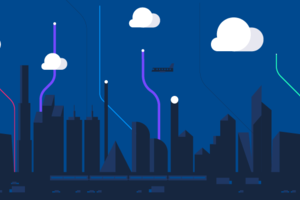Data is the new source of developmental power today, in which good quality data represents big value. On the flipside, bad data is costing businesses 30% or more of their revenue. In fact, Gartner has found the average cost of poor data quality on businesses amounts to anywhere between $9.7 million (€8.22 million) and $14.2 million (€12.03 million) annually.
This can make managing varying qualities of information and correcting it as best we can costly. But what if such processes could be improved? And what rewards can businesses reap by doing so?
Like many modern-day challenges, technology can provide solutions. IoT and blockchain can work together for mutual benefit, to play a leading role in managing this seemingly never-ending sprawl of misinformation, helping to restore trust and improve accountability, says Craig Price, SVP, mobility products and marketing at Console Connect by PCCW Global.
Digital trust
Providing trust is the most significant benefit of blockchain. It provides a decentralised or distributed way of managing information across parties, who do not necessarily trust each other, though have an interest in a common outcome.
The decentralised nature of blockchain utilising smart contracts are ideal for IoT, enabling IoT device registration, tracking, storage, and provisioning, as well as improving the transparency, traceability, and security of the data that is transmitted within IoT networks.
Because blockchain and smart contract models are based on cryptographically secured and immutably distributed ledgers, IoT networks can share data more securely across stakeholders, embed agreed-upon business terms to automate transactions, verify identification and authentication, and reduce costs by eliminating the intermediaries.
A blockchain layer added to an IoT network, which monitors and manages data flows, can be characterised as a technology ‘game changer’.
Complimentary technologies
Because of its distributed nature, blockchain can reduce friction within an IoT environment and help create new marketplaces. For example, this could be a marketplace that supports logistics management and enables users to track goods. Blockchain can provide cheap verification within this type of marketplace, but only once an attribute becomes digital.
This is where IoT can prove beneficial to blockchain (as well as vice-versa) as it can digitise real world attributes, such as location and temperature. IoT devices could also solve the “last mile” challenge currently facing blockchain, i.e. providing the bridge between a physical asset and its digital avatar on the chain. The credibility and effectiveness of a blockchain solution critically depends on “the way” or “the last mile” of bridging these two types of assets.
Value of blockchain within an IoT ecosystem
The value of blockchain and the provision of trust increases exponentially as the number of subsystems and parties increase. In this situation blockchain eliminates friction and provides traceability and transparency across operations, providing certifications, verifying credentials, and cheaply enabling settlement.
Blockchain can also address the lack of industry-wide standards for IoT networks and devices by adding significant value in data policy management. As data may not always be shareable to all parties in the blockchain ecosystem, a policy engine to determine how, when and who shares data is required.
Blockchain provides a solution by enabling a policy engine that can be trusted at different parts of the value chain, i.e. only the data you want to share is shared. Take the use case of container shipping: a container filled with goods is sent by truck to a government facility, then is shipped to another government facility, then is sent by truck again to a warehouse, where finally it reaches the point of sale.
A single container therefore generates a lot of data, which needs to be managed and exchanged. In this situation blockchain is a great technology for exchanging that data, settling transactions, and managing the policy across this blockchain ecosystem.
The challenges of introducing blockchain to an IoT ecosystem
There are 5 major challenges facing the convergence of blockchain and IoT technologies over the next few years. These are:
- Complexity – As highlighted with the shipping container example, there are many different parties within an IoT ecosystem, how do you manage all their interests?
- Governance – There is a challenge to obtain agreement from all users of a platform on the ownership of the data and the smart contracts.
- Scalability – Can be this technology effectively scaled to manage the sheer number of required transactions?
- Flexibility – Blockchain can be a rigid cryptographic format, how can you introduce more flexibility to this process?
- Cost – There can be a significant up-front and ongoing operational costs in applying blockchain to IoT, including investing in new tools to collect data, introducing new security measures and policies, and managing the flow of data across networks.
What does the future hold?
When combined with AI, IoT and blockchain could present vast benefits and opportunities to businesses in the future.
It is a future in which IoT provides the seamless interaction between machines, and blockchain eliminates error to improve trust. All underpinned by more informed decision-making through AI.
To put simply:
- Data is the new source of developmental power in society;
- It is captured by IoT devices;
- It is managed by distributed ledger technology;
- Coordinated and settled by crypto assets; and
- Actioned by smart contracts and AI
The use cases for IoT are growing all the time and the convergence of these technologies could happen rapidly.

PCCW Global is exploring how to incorporate blockchain technology within its own automated IoT connectivity offering called Console Connect IoT, and overcome the challenges of implementing blockchain. The platform currently leverages the latest network automation technology to provide end-to-end IoT connectivity, as well as seamless cloud connectivity, and the potential for blockchain-chain based transactions within this automated environment is significant.
Within the next five years, we could see a world where the boundaries between blockchain and IoT technologies disappear, and the flow of data improves immeasurably across many industries.
The author is Craig Price, SVP, mobility products and marketing at Console Connect by PCCW Global.
Comment on this article below or via Twitter: @IoTNow_OR @jcIoTnow










